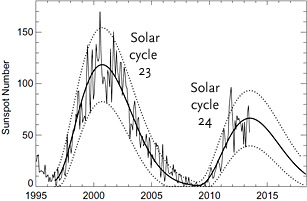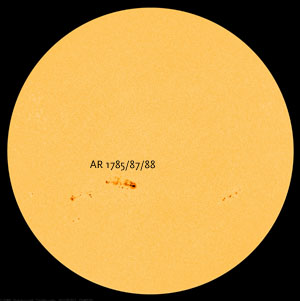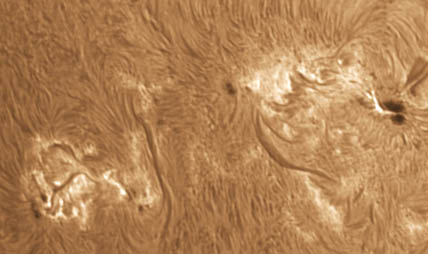A cluster of sunspots anchored by Active Region 1785 has blossomed to 94,000 miles in length — 12 times Earth's diameter — since rotating into view on July 2nd.

Solar cycle 24 has proven much weaker than its predecessor, both in terms of its sunspot counts and its eruptive activity.
D. Hathaway / NASA
The good news is that, to this point, solar cycle 24 hasn't produced much in the way of flare-triggered fireworks, so we've dodged the powerful solar storms that threaten orbiting satellites and our power grid.
The bad news is that pickings have been slim for telescopic viewing of the Sun's disk. As the chart here shows, the count of sunspots has trailed far behind that of the previous solar cycle.
But take heart: right now a huge group of spots is front and center on the Sun's disk for your viewing enjoyment.

A huge group of sunspots, anchored by Active Region 1785, is now crossing the Sun's disk. It's one of the largest groupings seen during solar cycle 24. NASA's Solar Dynamics Observatory captured this image on July 7, 2013. Click here for a larger view.
HM
Active region 1785 was already a biggie when it rounded the limb and into view on July 2nd, but since then "it has developed considerably," notes Tom Fleming, a Texas amateur who coordinates a small group of sunspot watchers. "Yesterday I counted 64 individual spots in the group under conditions rated as excellent," he adds. "This was the highest count (for me) for an individual group in this cycle."
Images from NASA's Solar Dynamics Observatory show AR 1785, together with neighboring disturbances 1787 and 1788, to be a chain of features that bear a slight resemblance to the Hawaiian Islands. But these are far, far larger, stretching some 95,000 miles (150,000 km) from end to end — 12 times the diameter of Earth! The biggest individual knot and the extended skirt (penumbra) surrounding it is roughly the size of Neptune.
So grab your telescope or binoculars — safely filtered for solar viewing! — and take advantage of this sizable sunspot group while you can. It's nearly centered in the Sun's disk. Here are tips on solar viewing from Robert Naeye, S&T's editor in chief.
If you're not equipped to view these sunspots yourself, then I highly recommend clicking the following link to view an incredible view by Damian Peach, taken yesterday with a 14-inch telescope and a ASI120MM camera. (With typical British understatement, Peach notes, "Frequent low clouds and haze caused problems, but seeing conditions were reasonable at times.")

A close-up view of Active Region 1785 (at right) as it appeared in hydrogen-alpha light on July 5, 2013.
S&T: Sean Walker
By the way, AR 1785 has not shown much evidence of eruptive activity, but its current location puts Earth directly in the line of fire. According to space-weather forecasters, for today there's a 55% chance that this group will unleash an M-class flare and a 10% chance of an X-class flare.
 0
0









Comments
You must be logged in to post a comment.